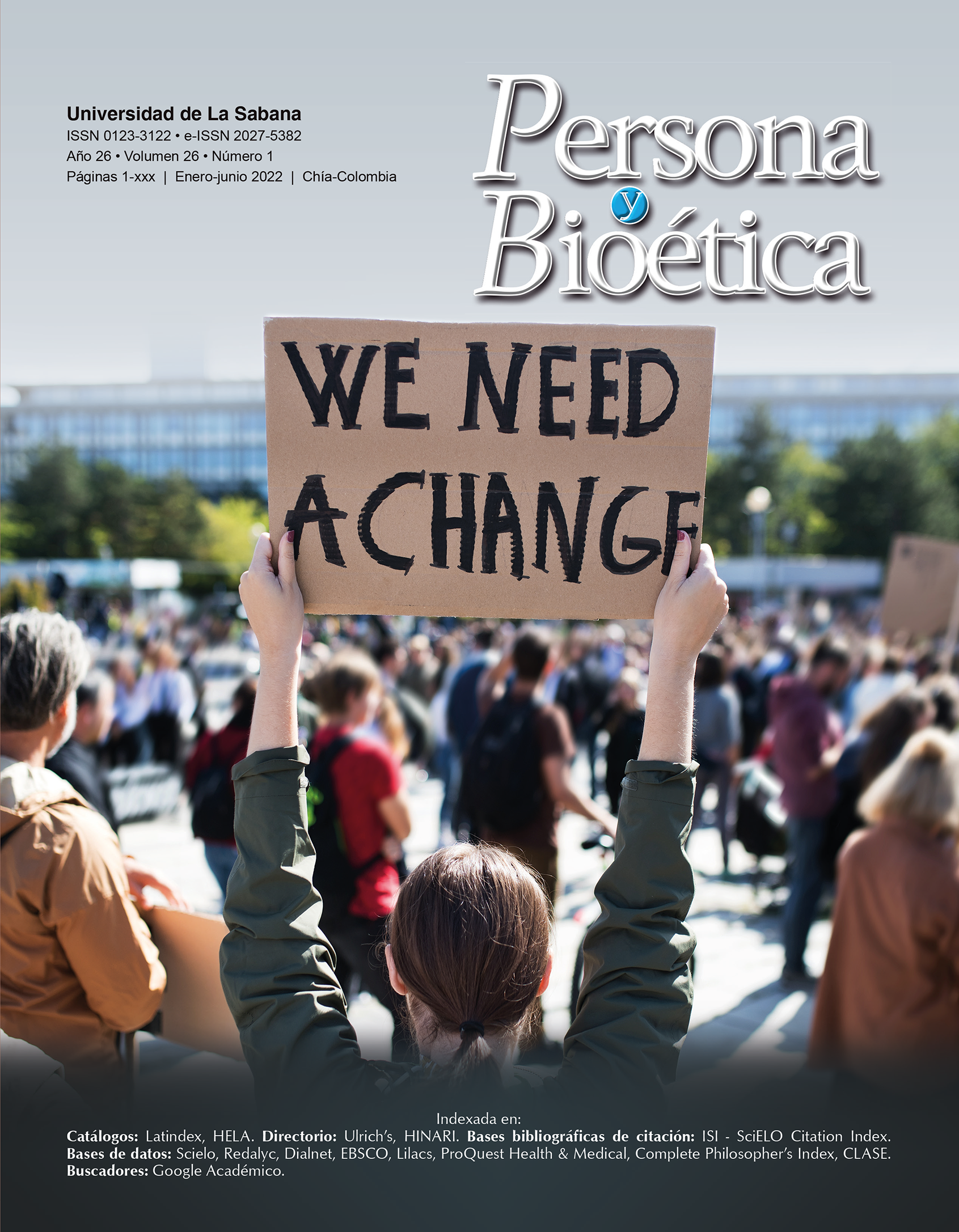Dignity and Genetic Eugenics: Regarding the use of CRISPR-Cas in human embryos
DOI:
https://doi.org/10.5294/pebi.2022.26.1.8Keywords:
Dignity, technology, eugenics, gene editing, CRISPR-CasAbstract
This article aims to address the discussion regarding dignity and genetic eugenics, reflecting on whether the use of methods such as CRISPR-Cas in the genetic editing of human embryos for their fertilization, constitutes a transgression or an affirmation of dignity. For this purpose, a concept of dignity is outlined, describing the project of biological transhumanism, as well as genetic editing in the eugenics project. After a theoretical and philosophical review, the existence of a duty to improve is questioned, and the need for a prior deliberation to recognize or not a right to improve is argued, as it is a public issue and not merely private.
Downloads
References
Peces-Barba G. La dignidad de la persona desde la filosofía del derecho. 2da ed. Madrid: Dykinson; 2004. 84 p.
Asís Roig R. La incursión de la discapacidad en la teoría de los derechos: posibilidad, educación, derecho y poder. En: Campoy Cervera I, editor. Los derechos de las personas con discapacidad. Perspectivas sociales, políticas, jurídicas y filosóficas. Madrid: Dykinson; 2004. pp. 59-73.
Campoy Cervera I. Una revisión de la idea de dignidad humana y de los valores de libertad, igualdad y solidaridad en relación con la fundamentación de los derechos. Anuario de filosofía del derecho. 2004;21:143-166.
Hume D. Tratado de la naturaleza humana. Libro III, Parte I. Duque F, traductor. Barcelona: Ediciones Orbis; 1984. 899 p.
Ferry L., La revolución transhumanista: cómo la tecnomedicina y la uberización del mundo van a transformar nuestras vidas. Martorell A, traductor. Madrid: Alianza Editorial; 2017. 216 p.
Buchanan A, Brock DW, Daniels N, Wilker D. From chance to choice: genetics and justice. Cambridge: Cambridge University Press; 2000. DOI: https://doi.org/10.1017/CBO9780511806940
Buchanan A. Better than human: the promise and perils of enhancing ourselves. Oxford: Oxford University Press; 2011. 207 p.
Ortega y Gasset J. Meditación de la técnica. En: Obras completas. T. V (1933-1941). 6ta ed. Madrid: Revista de Occidente; 1964. 632 p.
Rivera López E. Problemas de vida o muerte: diez ensayos de bioética. Madrid: Marcial Pons; 2011. 208 p.
Lema Añón C. Bionomía, bioética y derechos fundamentales. En: Tamayo J, editor. Bioética y religión. Madrid: Dykinson; 2007. p. 29-55.
Galton F. Inquiries into human faculty and its development. New York: Macmillan and Co.; 1883. DOI: https://doi.org/10.1037/14178-000
Galton F. Hereditary Genius: an inquiry into its laws and consequences. London: Macmillan and Co.; 1869. DOI: https://doi.org/10.1037/13474-000
Rabinovich-Berkman R. ¿Triunfó el nazismo? (o de cómo y hasta qué punto sobrevive hoy la cosmovisión bioética del nacionalsocialismo). Buenos Aires: Astrea; 2002. 20 p.
Lifton RJ. The Nazi doctors: medical killing and the psychology of genocide. New York: Basic Books; 1986. 561 p.
Laurence J, Franklin, M. Translating gene therapy to the clinic: techniques and approaches. London: Elsevier Science & Technology; 2015. 329 p.
Jansen R, Embden J, Gaastra W, Schouls L. Identification of genes that are associated with DNA repeats in prokaryotes. Mol Microbiol. 2002 mar;43(6):1565-575. DOI: https://doi.org/10.1046/j.1365-2958.2002.02839.x
Doudna JA, Stemberg SH. A crack in creation: gene editing and the unthinkable power to control evolution. New York: Houghton Mifflin Harcourt; 2017. 281 p.
Greely HT. CRISPR people: the science and ethics of editing humans. Cambridge: The MIT Press; 2021. DOI: https://doi.org/10.7551/mitpress/13492.001.0001
Regalado A. Exclusive: chinese scientists are creating CRISPR babies. MIT Technology Review. 2018 nov 25. Disponible en: https://www.technologyreview.com/2018/11/25/138962/exclusive-chinese-scientists-are-creating-crispr-babies/
Cyranoski, D. What CRISPR-baby prison sentences mean for research. Nature. 2020 ene 3;577:154-155. DOI: https://doi.org/10.1038/d41586-020-00001-y
Regalado, A. The creator of the CRISPR babies has been released from a Chinese prison. MIT Technology Review. 2022 abr 4. Disponible en: https://www.technologyreview.com/2022/04/04/1048829/he-jiankui-prison-free-crispr-babies/
Marx, V. The CRISPR children. Nature Biotechnology. 2021;39:1486-490. DOI: https://doi.org/10.1038/s41587-021-01138-5
Regalado, A. China’s CRISPR babies: read exclusive excerpts from the unseen original research. 2019 dic 3. Disponible en: https://www.technologyreview.com/2019/12/03/131752/chinas-crispr-babies-read-exclusive-excerpts-he-jiankui-paper/
Mallapaty, S. How to protect the first ‘CRISPR babies’ prompts ethical debate. Nature. 2022 feb 25;603:213-214. DOI: https://doi.org/10.1038/d41586-022-00512-w
Savulescu J. Genetic interventions and the ethics of enhancement of human beings. Gazeta de Antropología, 2016;32(2):art. 07. DOI: https://doi.org/10.30827/Digibug.43310
Agar N. Liberal eugenics: in defence of human enhancement. Oxford: Blackwell Publishing Ltd; 2004. 205 p. DOI: https://doi.org/10.1002/9780470775004
Miguel Beriain I. ¿Modificar o no modificar el genoma de nuestra descendencia? Algunos comentarios a raíz de la declaración del Comité de Bioética de España sobre la edición genómica en humanos. Rev. Bioética y Derecho. 2019;47: 55-75.
Sandel MJ. Lo que el dinero no puede comprar: los límites morales del mercado. Barcelona: Debate; 2013. 256 p.
Raposo VL. Gene editing, the mystic threat to human dignity. J Bioeth Inq. 2019 jun;16(2):249-257. DOI: https://doi.org/10.1007/s11673-019-09906-4
Miguel Beriain I, Sanz B. Human dignity and gene editing: additional support for Raposo’s arguments. J Bioeth Inq. 2020 jun;17(2):165-168. DOI: https://doi.org/10.1007/s11673-020-09969-8
Sandel MJ. Justicia: ¿hacemos lo que debemos? Barcelona: Debolsillo; 2012. 348 p.
Published
How to Cite
Issue
Section
License
Copyright (c) 2022 Enlil Iván Herrera-Pérez

This work is licensed under a Creative Commons Attribution-NonCommercial-NoDerivatives 4.0 International License.
Authors who publish with this journal agree to the following terms:
This journal and its papers are published with the Creative Commons License Attribution-NonCommercial-NoDerivatives 4.0 International (CC BY-NC-ND 4.0). You are free to share copy and redistribute the material in any medium or format if you: give appropriate credit, provide a link to the license, and indicate if changes were made; don’t use our material for commercial purposes; don’t remix, transform, or build upon the material.









